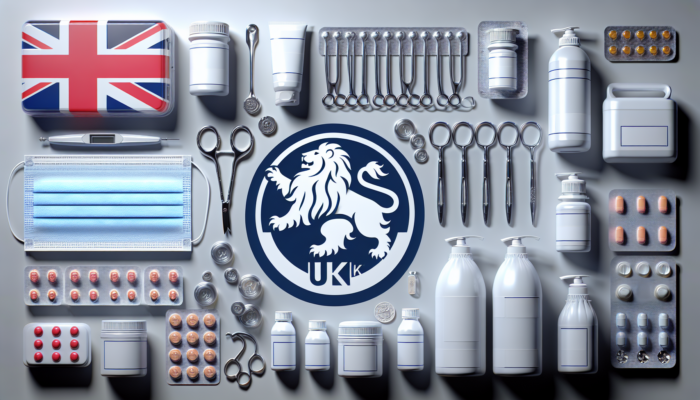Testing Your Healthcare Product: Essential Pre-Launch Steps
Ensuring Regulatory Compliance for Healthcare Products in the UK
Successfully testing your healthcare product before launch requires a thorough understanding of regulatory compliance in the UK, which is essential for any business operating in this sector. The UK healthcare market is governed by stringent regulations designed to ensure the safety and efficacy of healthcare products. By engaging with the necessary legal frameworks, you not only guarantee the integrity of your product, but you also foster trust among consumers and healthcare professionals alike. Each component of regulatory compliance, from grasping MHRA guidelines to ensuring compliance with UKCA marking, is vital during the testing phase of your healthcare product, as these elements significantly influence market access and credibility.
Mastering the MHRA Guidelines for Product Approval

The Medicines and Healthcare products Regulatory Agency (MHRA) serves as the primary regulatory body overseeing healthcare products within the UK. It is crucial for any company aspiring to launch a healthcare product to familiarise themselves with the MHRA guidelines. The initial step entails comprehending the specific type of product you aim to introduce to the market. The MHRA categorises products into various classes, each characterised by distinct requirements for testing and approval. For example, medical devices, pharmaceuticals, and combination products each follow unique pathways that dictate their testing protocols and regulatory requirements.
A significant aspect of the MHRA guidelines is the necessity for rigorous pre-market assessments. Products are required to undergo extensive evaluations that may include clinical trials and laboratory tests to confirm they meet established safety and efficacy standards. Furthermore, maintaining meticulous records throughout the testing process is of utmost importance, as the MHRA mandates that evidence of compliance must be readily available upon request. By diligently adhering to these guidelines, you not only comply with legal standards but also enhance your product’s credibility within the competitive UK market.
Ensuring Compliance with CE Marking Standards
Before launching your healthcare product in the UK, it is essential to ensure compliance with CE marking, particularly for products that were originally intended for the European market. The CE mark signifies that a product meets EU safety, health, and environmental protection standards. However, following Brexit, while the UK has introduced the UKCA mark, products already adorned with the CE mark may still be accepted for a transitional period, depending on their classification. Consequently, understanding the intricacies of CE marking is vital for any healthcare provider.
The process of obtaining a CE mark involves thorough product testing and extensive documentation, including risk assessments, technical files, and compliance declarations. In the case of complex devices, a notified body may be required to be involved, adding an additional layer of scrutiny to the approval process. This rigorous approach ensures that products are not only reliable and safe but also reinforces consumer confidence. As you prepare for your product launch, fulfilling all requirements associated with CE marking can help simplify your navigation through regulatory challenges.
Critical Documentation and Certification for Compliance
Preparing the requisite documentation and certifications is a vital aspect of achieving regulatory compliance in the UK healthcare sector. Comprehensive documentation acts as a roadmap outlining your product’s journey from development through testing to market readiness. Essential documents typically include a Declaration of Conformity, risk management files, and design dossiers, each specifically tailored to the product type and its associated regulations.
Moreover, maintaining meticulous records not only assists during regulatory interactions but also facilitates internal reviews and audits within your organisation. Regular updates to documentation reflect any modifications in testing procedures or product specifications, ensuring accuracy and compliance. In the UK, thorough and precise documentation is crucial, as it will be scrutinised by the MHRA during inspections. Properly managing this documentation can significantly enhance your product’s credibility and streamline the approval process.
Adhering to the UKCA Marking Requirements

With the introduction of the UKCA (UK Conformity Assessed) marking post-Brexit, it is imperative for businesses to ensure their healthcare products comply with this new standard before entering the UK market. The UKCA mark serves a similar purpose to the CE mark but is specific to Great Britain. Understanding the requirements for UKCA marking is essential, particularly for those businesses that previously relied solely on CE marking for compliance.
The UKCA marking applies to a diverse range of products, including medical devices and personal protective equipment. The transition from CE to UKCA necessitates a comprehensive understanding of the revised regulations, which may include additional testing or certification processes. Companies must adapt their compliance strategies accordingly to prevent disruptions in market access. Successfully navigating these regulations not only ensures legal compliance but also positions your product favourably in a competitive marketplace, facilitating smoother market entry.
Conducting Clinical Trials for Product Validation
Conducting clinical trials represents a cornerstone of the testing process for your healthcare product prior to launch. In the UK, these trials must be meticulously planned and executed to gather reliable data that demonstrates both safety and efficacy. Selecting appropriate trial locations, recruiting participants, and upholding ethical standards are all critical components of this comprehensive process.
Choosing Optimal Trial Locations for Effective Data Collection
Selecting suitable trial locations is crucial for the success of your clinical trials. The UK is home to a diverse array of medical facilities, ranging from NHS hospitals to specialised research institutions, each offering unique advantages. Choosing a location that aligns with your product type and target demographic enhances the relevance and reliability of your findings, ultimately contributing to the overall success of the trial.
For example, if your product addresses a specific condition prevalent in certain areas, collaborating with hospitals that specialise in treating those conditions can yield more comprehensive and relevant data. Furthermore, incorporating geographic diversity allows you to gain insights into how your product performs across varied populations, thus increasing its applicability and acceptance in the market. Engaging with local healthcare providers can also streamline participant recruitment efforts and enhance overall engagement.
Strategies for Effective Participant Recruitment in Clinical Trials

Recruiting a diverse group of participants is paramount for the credibility of your clinical trials. In the UK, employing various recruitment strategies can significantly widen your reach across different demographics. Approaches may include partnering with local healthcare professionals, utilising social media campaigns, and engaging community organisations to attract potential participants.
Moreover, ensuring that your recruitment methods are inclusive will enhance the quality of the data collected. Factors such as age, gender, ethnicity, and socioeconomic status should be carefully considered when selecting participants. A well-represented sample can provide invaluable insights into how different populations may respond to your healthcare product, ultimately improving its effectiveness and marketability.
Effective Data Collection and Analysis for Trial Integrity
The integrity of your clinical trial largely hinges on the implementation of effective data collection and analysis methodologies. Robust methodologies must be established to ensure that the data gathered is both valid and reliable, which is vital for regulatory submissions and product validation. Utilising electronic data capture systems can streamline this process, facilitating real-time monitoring of data quality and participant compliance.
Once data is collected, employing sophisticated analytical techniques becomes essential for accurately interpreting the results. Utilising statistical software can be invaluable in determining the significance of your findings and identifying trends within the data. Adhering to UK research standards during data analysis not only bolsters the credibility of your results but also prepares you for regulatory submissions, reinforcing the overall integrity of your healthcare product.
Securing Ethical Approval for Clinical Trials
Obtaining ethical approval is a fundamental step in conducting clinical trials within the UK. Submitting a comprehensive application to a Research Ethics Committee (REC) is necessary to ensure that your trial adheres to established ethical standards. This process involves providing detailed information regarding the trial’s objectives, methodology, and participant involvement.
Engaging with an ethics committee early in the planning phase can significantly expedite this process. They offer valuable feedback and guidance, assisting in addressing potential ethical issues before you submit your formal application. Securing ethical approval not only safeguards the rights and welfare of participants but also enhances your credibility in the eyes of regulatory bodies and potential investors, ultimately benefiting your product’s launch.
Monitoring Trial Progress and Reporting Findings
Ongoing monitoring of trial progress is vital to ensure compliance and safety throughout the clinical trial phase. Establishing a robust monitoring plan that includes regular assessments and check-ins can help identify potential issues early on, allowing for timely interventions to maintain trial integrity. This proactive approach not only protects participants but also ensures that the data collected remains valid and reliable.
Once the trial is completed, timely reporting of results to regulatory bodies, such as the MHRA, becomes essential. This includes submitting Clinical Study Reports, which detail the methodology, findings, and any adverse events encountered during the trial. Transparent reporting not only fulfills regulatory obligations but also builds trust with stakeholders, reinforcing the reputation of your healthcare product within the market.
Conducting User Testing to Enhance Product Usability
User testing is a pivotal component of product development, providing invaluable insights into the usability and effectiveness of your healthcare product. By engaging directly with end-users, you can refine your product to better meet the needs of healthcare professionals and patients alike, ultimately enhancing user satisfaction and market success.
Designing Effective User Testing Protocols
Developing user testing protocols tailored to the UK healthcare environment is essential for gathering meaningful feedback. Your protocols should take into consideration the specific needs and preferences of UK patients and healthcare professionals. This involves designing tests that reflect real-world scenarios, thereby allowing participants to interact with your product in a familiar context that mirrors actual usage.
Additionally, involving a diverse group of users in the test design process ensures that the insights gained are comprehensive and representative of the broader population. Creating scenarios that encompass various patient demographics will provide a more holistic view of how your product performs under different circumstances. Effective user testing protocols not only surface usability issues but also highlight areas for potential improvement, significantly enhancing the overall quality of your product.
Conducting Insightful User Feedback Sessions
Organising user feedback sessions with healthcare professionals and patients is critical for understanding their experiences and perceptions of your product. These sessions can take many forms, including focus groups, one-on-one interviews, and hands-on demonstrations, each offering unique opportunities for gathering feedback.
Facilitating discussions that encourage open communication can lead to rich insights regarding user expectations and challenges. It is important to create an environment where participants feel comfortable sharing their honest opinions without fear of judgement. This feedback can significantly inform product iterations, ensuring that your healthcare product is designed with the user at its core, ultimately increasing its chances of success in the market.
Analysing User Test Results for Continuous Improvement
Once user tests are conducted, analysing the results becomes essential to refine your healthcare product for the UK market. Employing qualitative and quantitative analysis techniques can help identify common themes in user feedback, as well as measure satisfaction levels against predefined benchmarks. This analytical approach allows you to pinpoint specific areas for enhancement.
Utilising statistical tools to interpret data from user tests can provide concrete insights into product performance and user preferences, ensuring that your product aligns closely with market needs. This analytical approach not only aids in refining your product but also prepares you for regulatory submissions, as demonstrating a user-centric design can significantly enhance your product’s credibility and acceptance within the healthcare sector.
Executing Comprehensive Market Research for Strategic Insights
Conducting thorough market research is crucial for understanding the healthcare landscape in the UK. This process involves identifying target demographics, analysing competitors, and gathering consumer insights to inform your product strategy prior to launch. A well-executed market research plan can greatly enhance your chances of success.
Identifying Key Target Demographics for Product Relevance
Understanding your target demographics is key to ensuring that your healthcare product meets the specific needs of UK consumers. Conducting demographic analyses enables you to segment your audience based on factors such as age, gender, income, and health conditions, allowing for more tailored marketing strategies.
Customising your product features and marketing strategies to resonate with these identified segments can significantly enhance market acceptance. For instance, if your product addresses chronic conditions prevalent among older adults, focusing on their unique needs and challenges can improve usability and effectiveness. Additionally, engaging with healthcare professionals during this phase can provide valuable insights into the patient populations they serve, further refining your target demographics.
Conducting In-Depth Competitor Analysis
A thorough competitive analysis is essential for positioning your healthcare product effectively within the UK market. Identifying key market players and understanding their offerings can reveal gaps in the market that your product can fill, thereby enhancing your competitive edge.
Assessing competitors’ strengths and weaknesses allows you to differentiate your product, whether through unique features, pricing strategies, or superior customer service. Additionally, analysing competitors’ marketing strategies can provide valuable insights into what resonates with consumers, informing your own promotional approaches and ensuring that your product stands out in a crowded marketplace.
Gathering Consumer Insights to Inform Product Development
Collecting consumer feedback is vital for understanding the needs and preferences of UK healthcare consumers. Employing surveys, interviews, and focus groups can yield both qualitative and quantitative insights that are instrumental in shaping your product development and marketing strategies.
Utilising digital platforms to reach consumers can broaden your reach and provide diverse feedback. Social media and online forums can serve as valuable resources for gathering real-time insights into consumer sentiment, helping you to adapt your approach based on emerging trends. This ongoing dialogue with consumers not only enhances product relevance but also fosters consumer loyalty even before your product launch.
Rigorous Safety and Efficacy Testing for Product Validation
Before launching your healthcare product, rigorous safety and efficacy testing is indispensable. Ensuring that your product meets UK healthcare standards not only protects consumers but also validates your product’s effectiveness, thereby fostering trust among stakeholders and regulatory bodies alike.
Establishing Stringent Safety Protocols
Establishing robust safety testing protocols is a critical step in safeguarding users of your healthcare product. These protocols should adhere strictly to UK healthcare regulations, encompassing everything from material safety to operational functionality.
Conducting comprehensive risk assessments can identify potential hazards associated with your product. Utilising standardised testing methods helps ensure that safety evaluations are consistent and reliable. Furthermore, keeping detailed records of safety testing can support regulatory submissions and enhance your product’s credibility in the eyes of healthcare professionals, ultimately contributing to a successful market entry.
Thorough Efficacy Evaluation for Market Readiness
Evaluating the efficacy of your healthcare product is crucial for demonstrating its effectiveness within the UK context. This process often involves controlled trials that measure outcomes against established benchmarks, providing evidence of your product’s performance.
Incorporating both clinical and real-world evidence can provide a holistic view of your product’s performance, ensuring that it meets the needs of the target population. Engaging with key opinion leaders and healthcare professionals during efficacy evaluation can yield valuable insights and lend credibility to your findings. Documenting these evaluations comprehensively will facilitate smoother regulatory submissions, showcasing your commitment to quality and safety, which is essential for consumer trust.
Comprehensive Reporting and Documentation for Compliance
Proper documentation of safety and efficacy test results is essential for compliance with UK regulatory requirements. This includes compiling detailed reports that outline testing methodologies, results, and conclusions drawn from the evaluations.
Incorporating clear and concise language will ensure that your documentation is easily understood by regulatory bodies. Timely submission of this documentation can expedite the approval process, allowing you to bring your healthcare product to market more swiftly. By maintaining rigorous documentation standards, you reinforce the integrity of your testing process and enhance your product’s overall credibility.
Running Pilot Programmes for Practical Product Testing
Running pilot programmes can serve as a vital step in the testing process, allowing you to assess your healthcare product in real-world settings before the official launch. Effective implementation and evaluation of these programmes can provide critical insights into product performance and user experience, ultimately informing necessary adjustments.
Selecting Appropriate Pilot Sites for Relevant Feedback
Choosing the right pilot sites is crucial for the success of your pilot programmes. Collaborating with UK healthcare facilities that align with your product’s target demographic can yield relevant insights into product performance and user requirements.
Consider factors such as the facility’s specialisation, patient population, and geographical location when selecting pilot sites. Engaging with healthcare professionals at these locations can also facilitate smoother implementation and enhance participant recruitment efforts. By selecting sites that reflect the intended market landscape, you can gather data that is both meaningful and actionable, providing a solid foundation for your product’s success.
Implementing Pilot Programmes with Clear Objectives
Implementing pilot programmes requires careful planning and execution to ensure they are effective and informative. Establishing clear objectives and timelines will guide the programme’s direction and ensure all stakeholders are aligned throughout the process.
Developing comprehensive training materials for healthcare professionals involved in the pilot can enhance their understanding and engagement with your product. Moreover, incorporating feedback mechanisms during the pilot programme will facilitate ongoing evaluation and adjustment, ensuring that the product meets user needs effectively and efficiently.
Evaluating Pilot Outcomes for Final Adjustments
Evaluating the outcomes of your pilot programmes is essential for determining the product’s readiness for market launch. This process involves analysing data collected during the pilot to assess product performance, user satisfaction, and overall feasibility in a real-world context.
Engaging with participants to gather qualitative feedback will provide deeper insights into the user experience, highlighting areas for improvement that may not have been previously identified. The findings from these evaluations can inform your final product modifications, ensuring that you are well-prepared for a successful launch in the UK market, backed by real-world evidence of your product’s effectiveness.
Establishing Robust Quality Assurance for Consistent Product Standards
Establishing a robust quality assurance (QA) framework is paramount for ensuring that your healthcare product meets UK standards throughout its lifecycle. Implementing comprehensive QA processes not only enhances product consistency but also builds trust with consumers and healthcare professionals alike.
Setting Up Quality Assurance Processes for Compliance
Setting up quality assurance processes that align with UK healthcare standards is essential for maintaining the integrity of your product. This involves creating standard operating procedures (SOPs) for each stage of the product development process, from initial design through to manufacturing and post-market surveillance.
Regular training sessions for staff involved in QA can enhance their understanding of compliance requirements and improve adherence to established processes. Establishing a culture of quality within your organisation fosters accountability and commitment to maintaining high standards throughout your product’s lifecycle, ultimately benefiting both the consumers and your business.
Conducting Regular Quality Assurance Audits
Performing regular quality assurance audits is vital for ensuring ongoing compliance with UK healthcare regulations. These audits should assess both internal processes and external suppliers, ensuring that all aspects of product development meet established standards and best practices.
Utilising a systematic approach to auditing, including checklists and performance metrics, will facilitate comprehensive assessments of compliance and quality. Following up on audit findings with corrective actions is essential for continuous improvement, reinforcing your commitment to quality and enhancing product reliability, which is crucial for market success.
Implementing Continuous Improvement Strategies Based on QA Feedback
Implementing continuous improvement strategies based on QA feedback is crucial for ensuring that your healthcare product remains competitive in the UK market. Regularly reviewing QA data can help identify trends and areas for enhancement, allowing for proactive adjustments that keep your product aligned with evolving consumer needs.
Encouraging feedback from all stakeholders, including healthcare professionals and patients, can provide valuable insights into potential improvements. By fostering an environment that prioritises quality and innovation, you are better positioned to meet changing consumer demands and maintain your product’s relevance and competitiveness in the marketplace.
Strategic Pre-Launch Marketing for Successful Product Introduction
Building brand awareness within the UK healthcare sector prior to your product launch is essential for ensuring market acceptance and success. Engaging effectively with healthcare professionals and consumers can set the stage for a successful introduction, ultimately driving product adoption.
Developing Strategies to Build Brand Awareness
Creating strategies that increase brand awareness within the UK healthcare sector is crucial for establishing a foothold in the market. This involves utilising a variety of marketing channels, including digital marketing, healthcare conferences, and professional networks to effectively reach your target audience.
Creating informative content that highlights the benefits and unique features of your healthcare product can engage potential users and position your brand as a thought leader in the field. Collaborating with influential healthcare professionals can also enhance credibility and expand your reach within the sector, providing a competitive advantage in a crowded marketplace.
Engaging with Healthcare Professionals for Valuable Insights
Engaging with UK healthcare professionals is a vital component of your pre-launch marketing strategy. Establishing relationships with doctors, nurses, and other healthcare providers can help you better understand their needs and preferences, ensuring that your product aligns with their expectations and requirements.
Hosting educational workshops, webinars, or roundtable discussions can facilitate meaningful interactions with healthcare professionals, providing opportunities for direct feedback and engagement. This level of engagement not only fosters trust but also opens avenues for valuable feedback that can further inform your product development and marketing strategies, ultimately enhancing your product’s chances of success.
Frequently Asked Questions about Healthcare Product Launches
What is the role of the MHRA in healthcare product testing?
The MHRA is responsible for regulating medicines and healthcare products in the UK, ensuring they meet safety, quality, and efficacy standards before they can be marketed to consumers.
How do I comply with UKCA marking requirements?
To comply with UKCA marking, ensure your product meets relevant safety and performance standards, conduct necessary testing, and prepare documentation to demonstrate compliance with UK regulations.
What are the key components of a clinical trial?
Key components of a clinical trial include selecting appropriate trial locations, recruiting diverse participants, collecting data, obtaining ethical approval, and continuously monitoring trial progress to ensure compliance and participant safety.
How can I gather consumer insights effectively?
Utilise surveys, focus groups, and social media engagement to gather feedback from a broad range of healthcare consumers, ensuring a diverse range of opinions and insights are considered in your product development.
What should I include in my product documentation?
Essential documentation should include a Declaration of Conformity, risk assessments, technical files, and any other relevant certifications that demonstrate compliance with UK regulations and standards for healthcare products.
Why is user testing important?
User testing provides direct feedback from healthcare professionals and patients, helping to identify usability issues and refine your product to better meet user needs and preferences, ultimately enhancing market acceptance.
What steps are involved in obtaining ethical approval for clinical trials?
To secure ethical approval, submit a detailed application to a Research Ethics Committee outlining your trial objectives, methodology, and participant involvement, ensuring adherence to ethical standards throughout the process.
How can I ensure ongoing quality assurance for my product?
Establish standard operating procedures, conduct regular audits, and implement continuous improvement strategies based on feedback and assessment results to ensure ongoing quality assurance and compliance.
What marketing strategies work best for healthcare product launches?
Utilise a mix of digital marketing, direct engagement with healthcare professionals, and informative content to build brand awareness and establish credibility within the healthcare sector prior to your product launch.
What is the significance of safety and efficacy testing?
Safety and efficacy testing is essential to verify that your product is safe for consumers and performs as intended, which is critical for regulatory approval and acceptance in the competitive healthcare market.














































